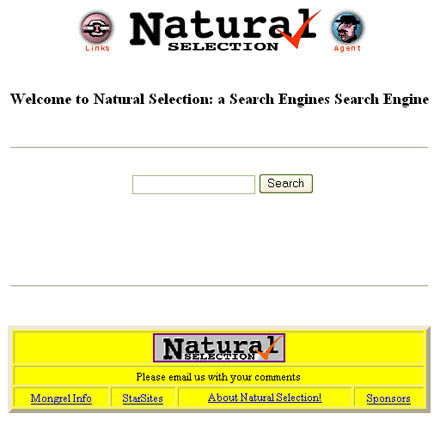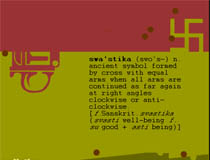 |
[March 30th 2004]

The Net Wants To Be Free - The Saga Continues
Interview with Jacob Lillemose
Kristine Ploug has asked Jacob Lillemose
(b. 1974) about his curation of the net art exhibition The Net
Wants To Be Free - The Saga Continues, in Basement which is
part of the RADAR festival. An exhibition that according to himself
is easily accessible instead of being digital weightlifting and
show off. Jacob is a MA in Modern Culture, specialising in
concept art, social criticism and software theory and is a part
of Artnode.
Translated by Sofie Paisley.
The Net Wants To Be Free - The Saga Continues
Net art exhibition with Natural Selection, The File Room, gatt.org
and Anti-Capitalist Operating System.
Basement
1 April - 4 April, open 1pm-7pm - no entrance fee
Enghavevej 42, København V
www.visitradar.dk
Tell us about the works in the exhibition. How were they selected?
The four works for the RADAR net art exhibition have been selected
as representatives of a widespread tendency within net art of dealing
with the net as a new kind of global public with equal parts commercial
traps, controlling power mechanisms and a critical and democratic
potential. Referring to Jürgen Habermas' concept of modernism
as a still incomplete project, the virtual intellectual Geert Lovink
has stated: "the internet is still an unfinished project".
I would like to concur with this. And without kidding myself that
the selected works in any way complete the project, I think that
they show ways towards continuing the development of the net as
a unique communicative network. This is also why I have chosen the
title "The Net Wants To Be Free - The Saga Continues"
which refers to the classic hacker motto, that information wants
to be free.
At the same time, the exhibition situation itself has played a
role. The exhibition will last for four days as part of a larger
arrangement with lots of other activities. It will therefore not
become the centre of attention, but a room that the audience will
pass on the way. I wanted to accommodate this with works you could
relatively easily understand and could use in a rather concrete
way. Above all, I wanted to avoid an experience dimension only addressing
experts, in the sense that you would have to know a lot about IT
to understand the works. So it's fully intentional that all four
works are formally rather simple. In other words, they are straightforward
invitations to interaction instead of digital weightlifting and
showing off.

Udsnit fra The File Room
The File Room (1994- ) is a classic within early net art,
and even though a lot has happened since the mid 90s where Muntadas
created it, I think it is still an important work for understanding
what the net is. It is simply an online catalogue of examples of
censorship from the birth of the civilised world and up to now,
with the opportunity for users all over the world of adding their
own examples. It's probably not able to counteract censorship, but
by using the net as a medium it exposes censorship in all its narrow-mindedness
and absurdity and reminds us that censorship becomes seriously dangerous
if we are unaware of its existence.

Søgeresultater fra Natural Selections
browser
Natural Selection (1998) by the collective group Mongrel
is somewhat an extension of this line of thought. It's a kind of
browser, which 'protects' the user against various politically incorrect
content on the World Wide Web. If you enter racist- or sex oriented
words such as 'Ku Klux Klan' or 'anal violence' you get a list of
search engine results, as you would, had you searched through Google.
Or so it seems. Although Natural Selection more or less lists the
same results as other search engines, most links are either dead
or take you to alternative sites created by Mongrel. The criteria
for selecting the links are in this way not commercial, as is the
case with the browsers most of us use daily, but ethical and political.
I see it as a prototype of customised browsers where the users set
their own criteria for their search for information, at the same
time as it hopefully can make us more critical towards the results
the browsers present us with.
 
Nogle af søgeresultaterne fra Natural Selections
browser
 Anti-Capitalist Operation System 2.0
Anti-Capitalist Operation System 2.0
Both gatt.org (1999- ) and Anti-capitalist Operating
System 2.0 (2002) by The Yes Men and Together We Can
Defeat Capitalism are declared anti-capitalist works that in
each their way, with humour, play subversive tricks on the symbols
of financial powers. Gatt.org is in appearance a copy of WTO's homepage
posted on the address gatt.org, the initials of the organisation,
which was named The General Agreement on Tariffs and Trade until
1995. Even though the site is, contentwise, obviously WTO-critical,
people have mistaken it for the real thing and invited The Yes Men
to different conferences as representatives of the WHO. How that
turned out can be seen in the film The Horribly Stupid Stunt that
is also part of the exhibition. Anti-capitalist Operating System
2.0 in a similar way uses the design of Windows 98 to create a platform
for the politically aware media user. It contains links to video
documentary, networks, texts and digital tools to fight Microsoft's
standardization of the net. They are both rounded by an activist
way of thinking, which at times can seem naïve and high-strung,
but at the same time they are rather ingenious in their use of the
net's possibilities of using the instruments and symbols of power
against itself.

Uddrag fra gatt.org
The exhibition is almost historical. Why is it interesting to
take a historical retrospective glance at an art that has only existed
for about 10 years?
The historical retrospective glance isn't something I make a big
deal about. I just think that the newest works aren't always the
best, and that there are a number of important realisations in earlier
works, which would be good to 'consult' within a field that is often
preoccupied with the new.
But even so it must play a role - the historic aspect. The File
Room is often referred to as the first ever net artwork.
True, The File Room is often referred to as one of the first
net artworks, and that I have selected it is a expression of my
opinion that net art (whatever that is?) must look back or in other
directions, and consider the conceptual and aesthetic use of the
internet, instead of being solely fixated on technological capacity
and development: what is possible, how good it can look and how
complicated it can be set out. And with this I mean that The File
Room in all its innocence offers a good example of how a global
digital network can be used in relation to the socially critical
tendencies found in contemporary art from the 50s and onwards.
What thoughts have you had about exhibiting net art at all?
I am, of course, aware of the paradox of getting people to go to
a place to see something that they could just as well have seen
on their computer at home. But with the current situation there
is a need for a presentation of net art, both making people aware
of the works and also placing the works in a context which isn't
'out there in cyberspace where only the initiated can find their
way', but here in our world with a connection to lived experiences
and simultaneously giving the users a language for understanding
the works. And in this connection, I think that a physical exhibition
space/ an institution has its legitimacy. It can contribute to remedying
a widespread alienation among the people not acquainted with the
phenomenon. That a lot of institutional problematics emerge is obvious,
and I agree that it isn't optimal or unproblematic to exhibit net
art, but at the same time I think that you have to lose the paranoia
towards any kind of connection to the institution (even if this
is not currently as big a problem as earlier, where net art considered
itself as being avant-garde). The institution is currently comparatively
spacious and can help the project of net art. That the institution
would do injustice to net art, I think is a misunderstanding of
the institution and of net art itself. It is certainly not the case
with an exhibition like this one.
The arrangement of a round table with four computers plugged into
the internet, each 'dedicated' to a work by a link on the desktop
and a brief introductory text to the left of the keyboard, is inspired
by transmedia.04
that had a similar arrangement which functioned positively in spite
of the works being far more complex.
All the works can - of course - also be viewed on the net:
The File Room: http://www.thefileroom.org/
Natural Selection: http://www.mongrel.org.uk/
Anti-capitalist Operating System 2.0: http://www.twcdc.com/help.htm
www.gatt.org
|
 |
|